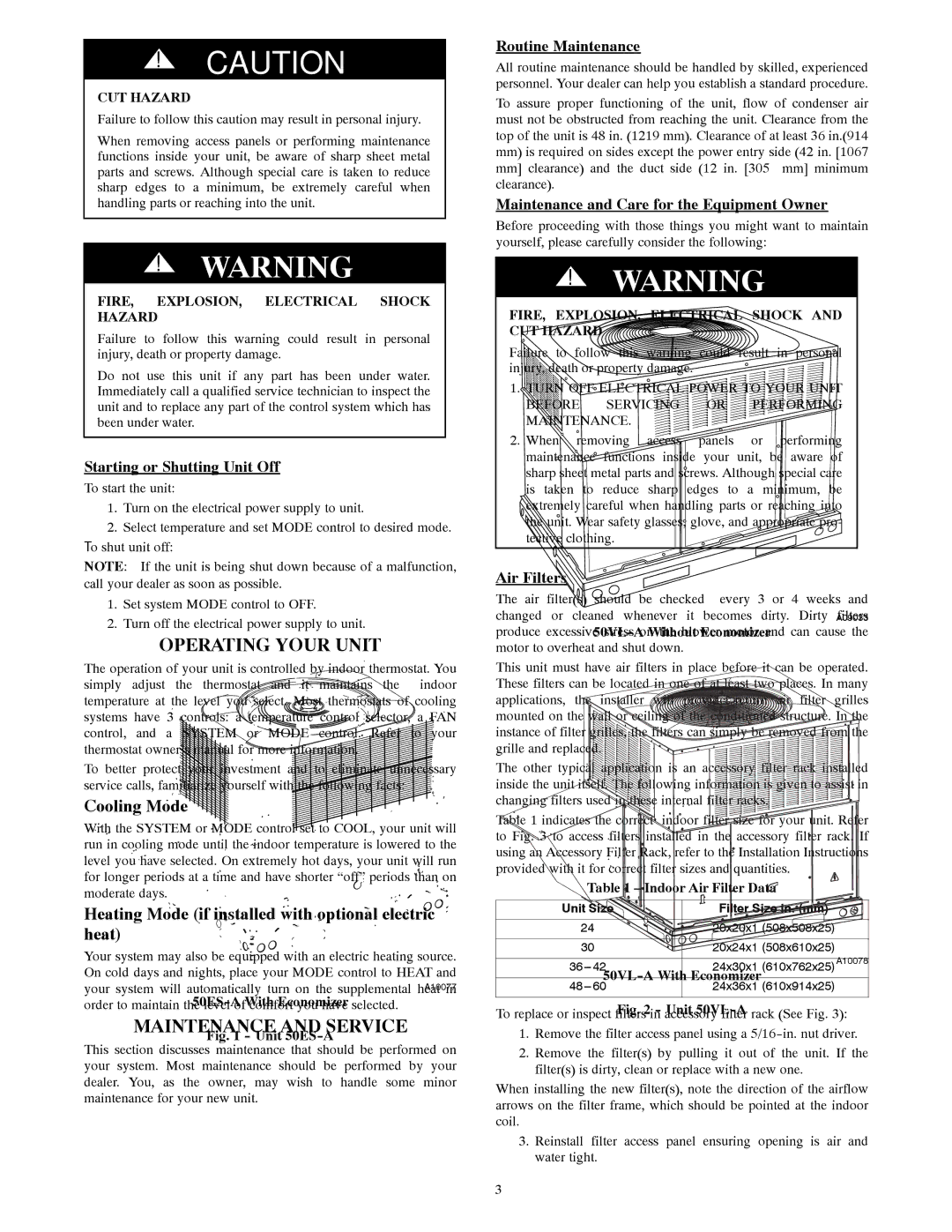!CAUTION
CUT HAZARD
Failure to follow this caution may result in personal injury.
When removing access panels or performing maintenance functions inside your unit, be aware of sharp sheet metal parts and screws. Although special care is taken to reduce sharp edges to a minimum, be extremely careful when handling parts or reaching into the unit.
!WARNING
FIRE, EXPLOSION, ELECTRICAL SHOCK HAZARD
Failure to follow this warning could result in personal injury, death or property damage.
Do not use this unit if any part has been under water. Immediately call a qualified service technician to inspect the unit and to replace any part of the control system which has been under water.
Starting or Shutting Unit Off
To start the unit:
1.Turn on the electrical power supply to unit.
2.Select temperature and set MODE control to desired mode. To shut unit off:
NOTE: If the unit is being shut down because of a malfunction, call your dealer as soon as possible.
1.Set system MODE control to OFF.
2.Turn off the electrical power supply to unit.
OPERATING YOUR UNIT
The operation of your unit is controlled by indoor thermostat. You simply adjust the thermostat and it maintains the indoor temperature at the level you select. Most thermostats of cooling systems have 3 controls: a temperature control selector, a FAN control, and a SYSTEM or MODE control. Refer to your thermostat owner’s manual for more information.
To better protect your investment and to eliminate unnecessary service calls, familiarize yourself with the following facts:
Cooling Mode
With the SYSTEM or MODE control set to COOL, your unit will run in cooling mode until the indoor temperature is lowered to the level you have selected. On extremely hot days, your unit will run for longer periods at a time and have shorter “off” periods than on moderate days.
Heating Mode (if installed with optional electric heat)
Your system may also be equipped with an electric heating source. On cold days and nights, place your MODE control to HEAT and your system will automatically turn on the supplemental heat in order to maintain the level of comfort you have selected.
MAINTENANCE AND SERVICE
This section discusses maintenance that should be performed on your system. Most maintenance should be performed by your dealer. You, as the owner, may wish to handle some minor maintenance for your new unit.
Routine Maintenance
All routine maintenance should be handled by skilled, experienced personnel. Your dealer can help you establish a standard procedure.
To assure proper functioning of the unit, flow of condenser air must not be obstructed from reaching the unit. Clearance from the top of the unit is 48 in. (1219 mm). Clearance of at least 36 in.(914
mm)is required on sides except the power entry side (42 in. [1067 mm] clearance) and the duct side (12 in. [305 mm] minimum clearance).
Maintenance and Care for the Equipment Owner
Before proceeding with those things you might want to maintain yourself, please carefully consider the following:
!WARNING
FIRE, EXPLOSION, ELECTRICAL SHOCK AND CUT HAZARD
Failure to follow this warning could result in personal injury, death or property damage.
1.TURN OFF ELECTRICAL POWER TO YOUR UNIT
BEFORE SERVICING OR PERFORMING MAINTENANCE.
2.When removing access panels or performing maintenance functions inside your unit, be aware of sharp sheet metal parts and screws. Although special care is taken to reduce sharp edges to a minimum, be extremely careful when handling parts or reaching into the unit. Wear safety glasses, glove, and appropriate pro- tective clothing.
Air Filters
The air filter(s) should be checked every 3 or 4 weeks and changed or cleaned whenever it becomes dirty. Dirty filters produce excessive stress on the blower motor and can cause the motor to overheat and shut down.
This unit must have air filters in place before it can be operated. These filters can be located in one of at least two places. In many applications, the installer will provide return air filter grilles mounted on the wall or ceiling of the conditioned structure. In the instance of filter grilles, the filters can simply be removed from the grille and replaced.
The other typical application is an accessory filter rack installed inside the unit itself. The following information is given to assist in changing filters used in these internal filter racks.
Table 1 indicates the correct indoor filter size for your unit. Refer to Fig. 3 to access filters installed in the accessory filter rack. If using an Accessory Filter Rack, refer to the Installation Instructions provided with it for correct filter sizes and quantities.
Table 1 – Indoor Air Filter Data
Unit Size | Filter Size in. (mm) |
24 | 20x20x1 (508x508x25) |
30 | 20x24x1 (508x610x25) |
36--- 42 | 24x30x1 (610x762x25) |
48--- 60 | 24x36x1 (610x914x25) |
To replace or inspect filters in accessory filter rack (See Fig. 3):
1.Remove the filter access panel using a 5/16-in. nut driver.
2.Remove the filter(s) by pulling it out of the unit. If the filter(s) is dirty, clean or replace with a new one.
When installing the new filter(s), note the direction of the airflow arrows on the filter frame, which should be pointed at the indoor coil.
3.Reinstall filter access panel ensuring opening is air and water tight.

